Tents pegs for hiking
Hiking Practice
When it comes to choosing a new shelter many hikers will spend weeks, or if you’re like me, months trawling through reviews and facts from different sources to pick out that ‘perfect’ shelter to suit your needs. What surprises me is that while we will spend so much time choosing one of our most expensive hiking purchases, we typically give little thought to the tent pegs that come with the shelter and will often use them without giving a second thought. I have owned some excellent tents over the years and it surprises me how often they are accompanied with sub standard tent pegs.
In the 1980s in Australia there was a TV ad for a well known oil brand with the catch phrase of ‘Oils ain’t Oils. The premise of the ad was that while motor oils tend to look the same, it’s not until you look into the underlying features, specifications and performance that you realise sometimes paying a little bit extra provides a much better experience.
The same can be said about tent pegs. Choose the right pegs and your tent should stay put in almost any conditions; choose the wrong pegs and you may find yourself shelterless at the most inconvenient time.
Unless you camp in exactly the same location, with the same soils and the same environmental conditions, it’s unlikely you’ll get away with one particular type of tent peg for all your hiking needs.
In this article we look at a range of different tent peg types used for hiking tents, talk about when to use them, and make suggestions based on what we use.
Hook Stakes
Hook stakes are very much the original stake. They are essentially a straight length of metal with a small section at the top bent over proving a handy little hook and keeping guy lines in place. I remember the long heavy steel stakes from my childhood but mind you in those days the tents weren’t the lightest things either. This type of stake keeps the tent guy line from coming off and provides a mechanism to easily pull the peg out of the ground when breaking camp. As a result, these pegs typically don’t come with a small nylon loop to assist removal that other pegs have.
Over the years they have progressively lost some popularity as a broader variety of pegs have come onto the market but they still rank as one of the most popular and common stakes around. There two main reasons that you still come across hook stakes is because they work so well in hard rocky soils and because they are so cheap.
When we hiked the Larapinta Trail in 2016 we discovered that there was a variety of soil types along the trail but by far the most common was a soil that could be best described as rock with a bit of soil. On a number of occasions we couldn’t get the broader stakes into the ground and ended up using rocks instead of pegs. Price wise just about all outdoor stores sell a range of hook stakes that vary in length and price but they typically sell for under $3 each.
The main disadvantages of these stakes is that the cheaper options bend easily and because of their narrow profile which allows them to penetrate hard ground, they also don’t hold that well in softer ground. Hook stakes are almost a disposable item and almost any time I find a tent stake on the trail, its typically one of the cheaper bent hook stakes.
Best Uses
- Work well in harder soils and rocky soils where other stake types struggle to penetrate the ground
- Cheap compared to other types of stakes
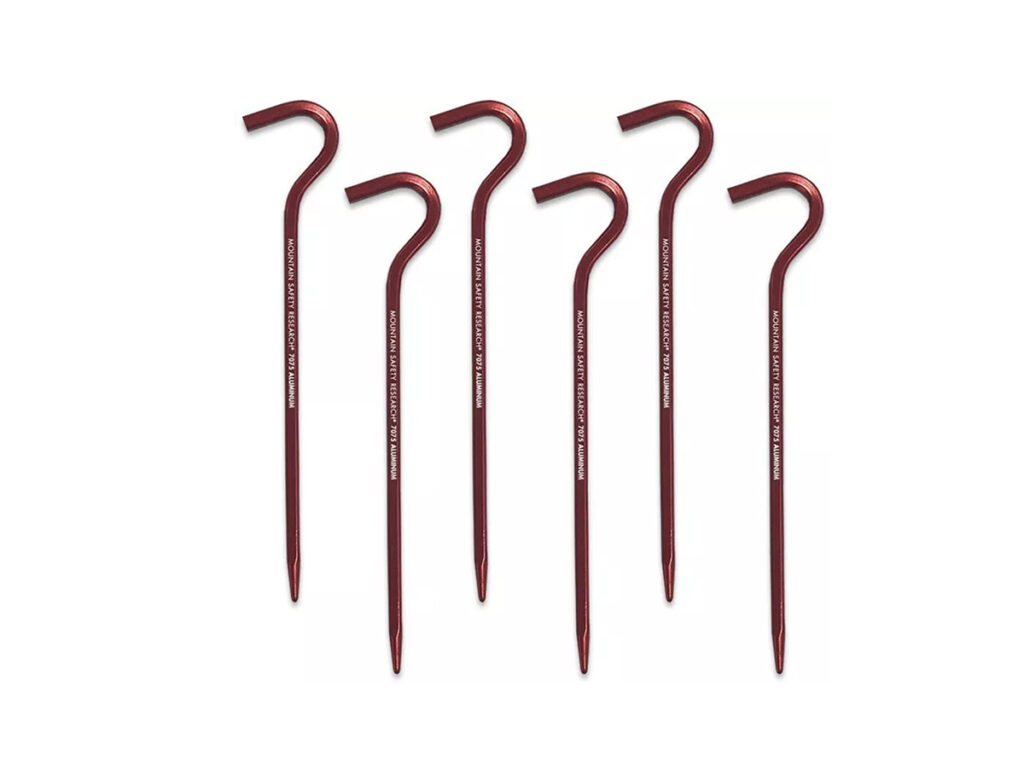
MSR Hook Stakes ( no longer on the market were the highest quality of this type of stake). If purchasing this type of stake treat them as disposable
Y Stakes
‘Y’ stakes have become a very common type of stake these days and they get their name from the shape. If you look downwards at the top of the stake you see a three vaned peg that resembles a Y. This shape means that once you drive it into the ground, it is less likely to twist. Having said that if the ground is very rocky or hard sometimes its almost impossible to drive the stakes into the ground.
The main disadvantages of this type of stake is that they are some of the most expensive on the market and can cost up to $10 per stake with even the cheaper options costing around $5 per stake. The other and probably the main disadvantage of these stakes is that typically the tops of the stakes are sharp and if you ever kicked one in the middle of the night, you will know about it. If you are going to use these stakes, choose one that has a reflective pull cord which makes them easier to remove. A reflective chord also means they stand out so much more when its dark so long as you are using a light source of some type.
Best Uses
- Works well in average soils providing they aren’t too hard or too soft

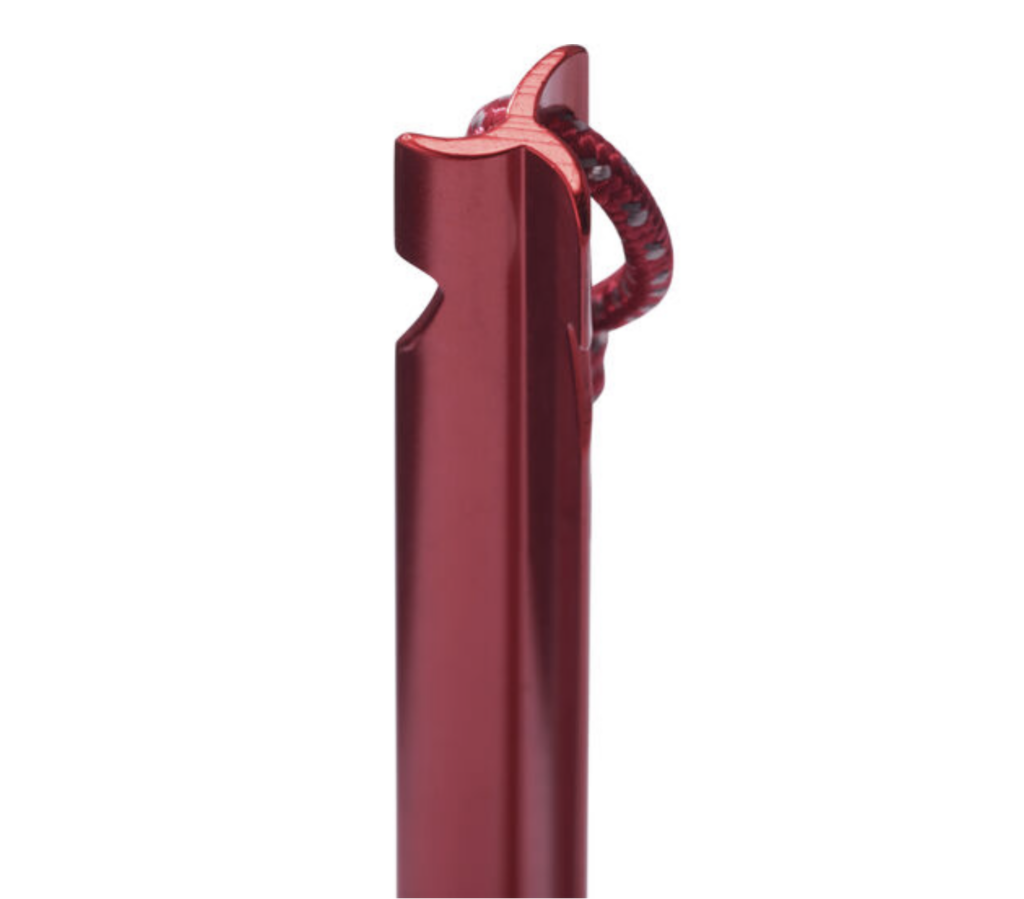
The above two images show the best known example of this type of stake the MSR Groundhog. The Y shape is visible in the lower image when looking down from the top of the peg
Sand / Snow Pegs
There are a number of specialist types of pegs but by far one of the most common are the flatfish sand/snow pegs. These pegs aren’t that common on Australian trails and in all honesty we don’t use then that often ourselves.
These are an ideal stake for soft wet soils, sand or snowy conditions. Our main use for these is a bit creative and that’s on tent platforms as shown in the images below. These stakes are long enough and flat enough that they will wedge between the gaps of the typical wooden tent platforms used on trails like the Overland Track and the Kangaroo Island Wilderness Trail. We’ll usually only cary two of these unless we are expecting to have to set up in a very sandy area.
These pegs cost around $14.40 each which puts them at the upper end of tent peg pricing.
Best Uses
- Works well in sandy or snowy conditions
- Great for camping on wooden tent platforms which is how we use them
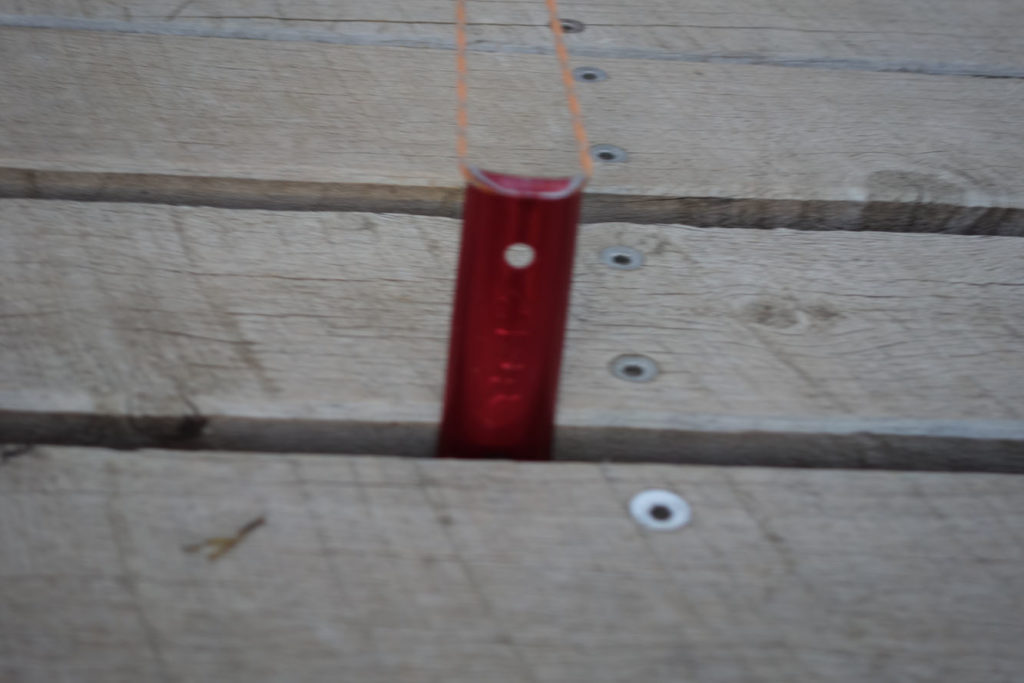
An MSR Blizzard Tent Stake used in the gaps on a tent platform on the Overland Track in Tasmania. We have used this method on both the Overland Track and the Kangaroo Island Wilderness Trail
Wind Stakes
The name ‘Wind Stake’ is one that you aren’t going to find anywhere in magazines or stores. Rather it’s a name that clearly describes the function of what this type of stake does. These stakes very much fall into the specialist category and in all honesty I haven’t seen them used in the field although they definitely have their place.
The best known version of this stake is the MSR Cyclone Stake which is designed to provide extreme grip in open windy areas that are typical in the Australian alpine regions. If you have no option to get out of the wind in the Australian alps or other similar open areas, then this is really the only stake that you want.
These pegs cost around $14.50 each which puts them at the upper end of tent peg pricing.
Best Uses
- Works well in soft to firm soils
- One of the best stakes to use in areas with high winds. If you use this type of stake properly, the tent is more likely to give way rather than the pegs
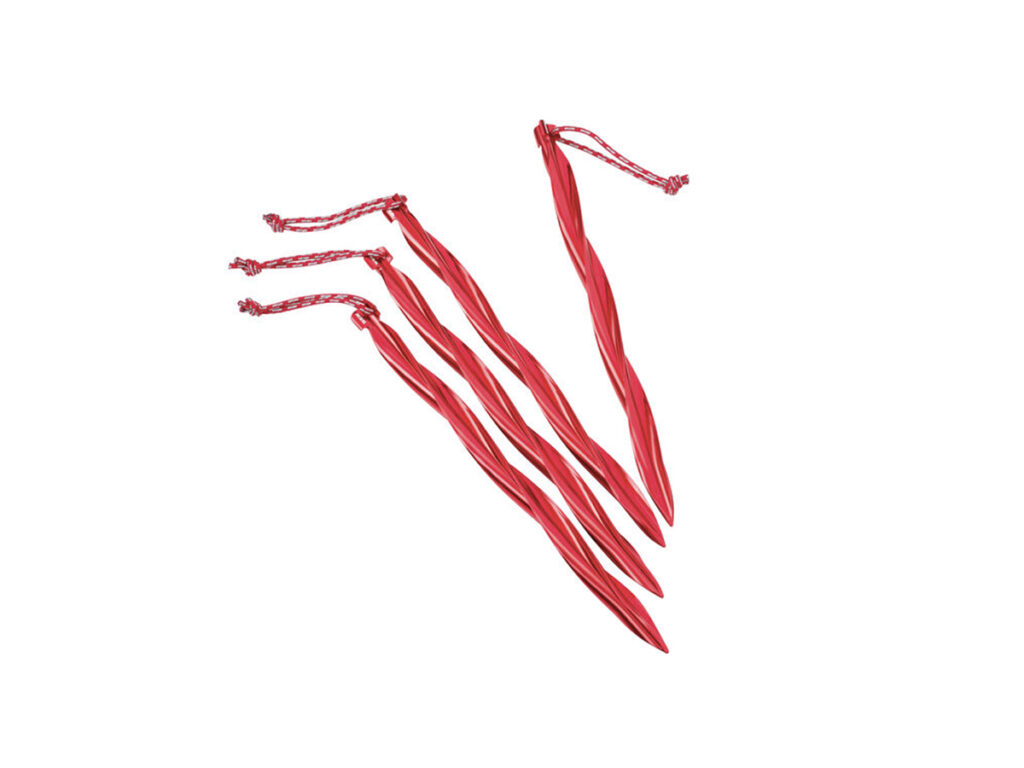
MSR Cyclone Tent Stake. This stake is 24 cm long – the twisted veining (that almost looks like red licorice) provides extra gripping power in high wind areas. Use this stake correctly and the tent will give way in windy conditions before the pegs do
How many tent pegs and what type?
While I will assess my gear requirements for any hike I do on a case by case basis, I tend to have a range of equipment to draw from and this includes tent pegs. I rarely if ever lose tent pegs and I own more than enough pegs to last me for the rest of my life. But just like the rest of my gear I will swap out my pegs to suit the conditions.
How many pegs to carry?
I will always carry enough pegs to tie down the tent including the additional guy lines that are only used when the conditions are windy. The time you don’t cater for this is the time that the wind comes up. I have seen tents flattened in windy conditions without using these additional tie off points. Currently my two person tents require the following for full tie down:
- One peg for each corner of the tent (4)
- One peg for each door (2)
- One peg for the narrow end of the fly (1)
- Two pegs for the wide end of the tent (2)
- Total peg carry 9 pegs
You can be creative and use rocks and branches but I wouldn’t rely on that. You’ll notice from the lists below that I rely heavily on using MSR stakes. Put simply MSR make the best tents stakes around and while they will definitely cost you more, they will outlast most other tents stakes.
What I use on an average hike
Here is what I use on an average hike when I’m not expecting very windy conditions on soil that is average for Australian conditions (firm):
- MSR Mini Groundhog Tent Stakes x 7
- Hook Tent Stakes x 2
What I use on a hike with very sandy soils and or timber tent platforms
If I’m beach camping, I will use 9 x Blizzard Stakes
What I use on a hike where I expect extreme winds
Using your stakes
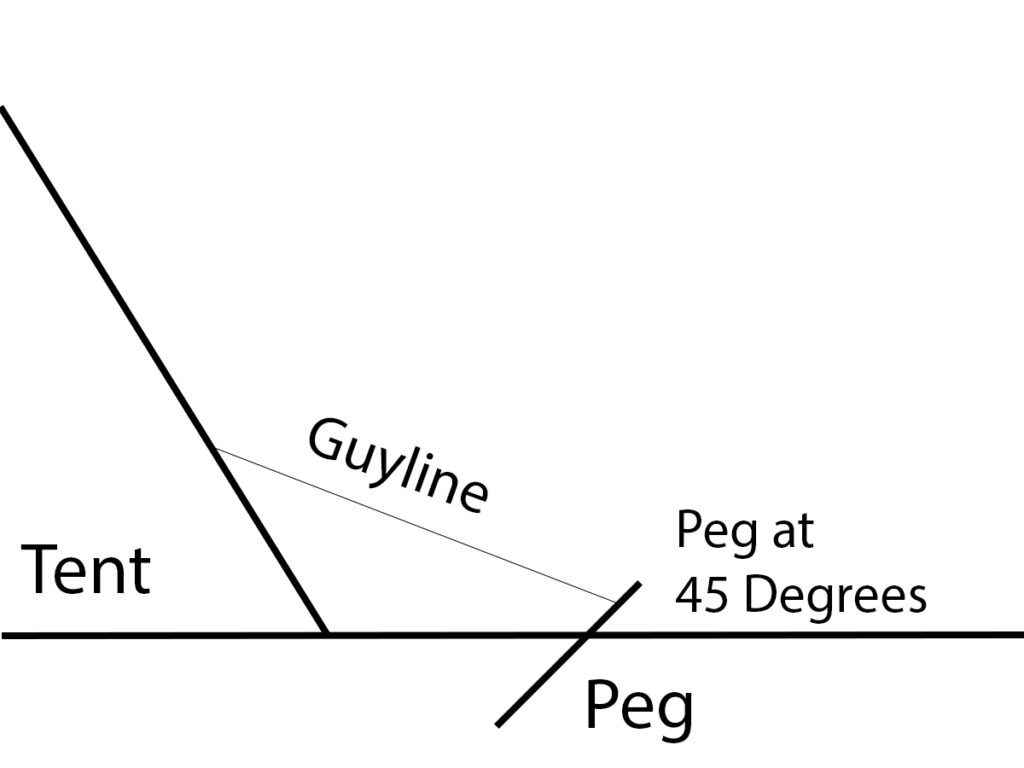
Tents pegs should be driven into the firmest ground possible given the environment you are in. Drive the stakes in at approximately 45 degrees and deep enough so the guyline is just out of the ground. This will mean the the pressure on the stake is downward as well as inwards and ensure the stake doesn’t pull out in firmer soils
Last words
There are many other types of tent pegs on the market and if you find what comes with your tent works for you then you may not need any additional or replacement pegs. Having said that most tent manufacturers will typically provide you with enough pegs to set your tent up in typical conditions but not enough to fully guy out your tent in harsher weather. This means that you will typically need to purchase at least a couple of pegs extra. In addition, often the pegs that come with your new tent will be very basic pegs that will work well in average conditions but nothing too extreme.
The other thing that you may have noticed with the peg examples used this article, is that they are pretty much all metal stakes. Plastic stakes are reserved for car camping options these days but it may surprise people new to hiking.
If there is only one thing that you takeaway from this article then it should be to put the effort into selecting the right tools for the job, or in this case the right tent pegs. For most hikes this may mean working with a catch-all set of pegs that will cover you for all but the most difficult conditions. Alternatively you can buy a range of pegs so you can choose a set of pegs for each hike targeted to the conditions. But that will end up costing you a bit more; your choice.